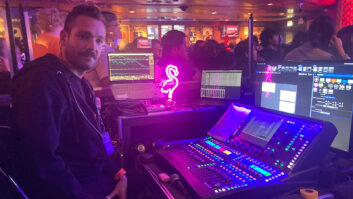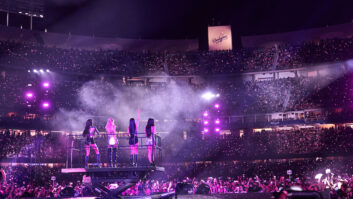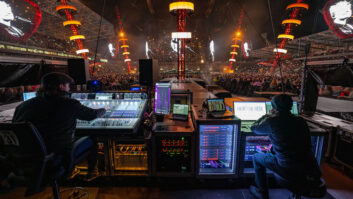
Jamiroquai’s Jay Kay sings through a Sennheiser 935 wireless mic
Photos: Steve Jennings
The ever-stylish Jay Kay didn’t even stop to change his bizarre hat as he wore out a path in front of his band, Jamiroquai, while belting out two hours’ worth of high-energy, disco-dance-funk at San Francisco’s historic Fillmore Auditorium in early November. Looking like a sci-fi pirate in street clothes, Kay and band played a mix of vintage funk — influenced tunes from earlier albums and upbeat grooves from the new release, Dynamite, for the sold-out, keyed-up crowd, who, like their star performer, didn’t stop dancing the whole night.
Keeping everything sonically in check are front-of-house engineer Rick Pope (also Jamiroquai’s studio engineer), monitor engineer Andrew Thornton and audio tech Chris Peters, all a bit weary but in high spirits as they neared the end of the U.S. leg of a lengthy world tour.
Working with UK-based sound company Britannia Row, Jamiroquai travels with seven trucks’ worth of L-Acoustics arrays and other equipment in Europe, where they played mostly arenas. They scaled down for the U.S. dates, relying on house P.A. but bringing their own consoles, mics, outboard and amps. Traveling light makes for easier workdays in the States, but on the first of two nights at The Fillmore, Pope expresses concern over the placement of the venue’s house system, which includes three Meyer M3D powered line arrays (flown) per side, three Meyer M3D powered line array subs per side, a Meyer DF-4 powered in-fill per side (underhung) and one flown Meyer CQ-2 for center-fill. “Jay doesn’t have one of the strongest voices, so I need all the P.A. I can get, really,” he says. “And we always have it as far forward as possible. But with the P.A. where it is [hung low, close to the stage], it can only go so far before it feeds back. And this is a dance band, so you’ve got to have it loud; not real loud, but pumping.”

Front-of-house engineer Rick Pope
Despite reservations, Pope mixes the show sans feedback on a Yamaha PM1D Version 2 digital system, and records both shows to Kay’s Pro Tools rig, which he bought when the band began work on Dynamite. “We’ve been recording every show since 1999, so we have about 250 shows on either DA-88 or Pro Tools,” says Pope. “Most of them we may never even listen to, but Jay likes to have them on file.”
Pope mixes Kay’s vocals, which are sung through a Sennheiser 935 wireless mic, through a Manley VoxBox and an Eventide H3000. Save for an occasional nod to a Lexicon PCM81 or 91, all other processing comes through the Yamaha desk. Miking is equally straightforward: The three background vocalists are miked with Sennheiser 935s, AKG 414s on drummer Derrick McKenzie’s overheads, Beta 98s on the kick and toms (and percussionist Sola Akingbola’s congas) and Audio-Technica 4050s on Rob Harris’ guitars. Matt Johnson’s keyboards go direct and Paul Turner’s bass goes through a Ridge Farm Gas Cooker DI box before hitting the PM1D.

Monitor engineer Andrew Thornton takes a break at the maxed-out Yamaha PM5D.
Over at monitor world, Thornton works on a maxed-out Yamaha PM5D, with all compression and EQ coming from the desk. The band wears Sennheiser in-ears, while Kay listens to them through 10 EAW SM15 wedges and two EAW SM12s driven by Lab.gruppen LA48 amps with Klark Teknik crossovers “for a really high-powered wedge,” Thornton says. “Jay really likes high end, so it’s super bright onstage, and those wedges have a really great high-end sound.” For sidefills, the group relies on the venue’s Meyer MSL3s.
Monitor mixes are kept at a reasonable level. “Jay has a very simple mix onstage,” says Thornton. “He listens to most of the band acoustically, and his wedges pretty much have just keyboards and piano, so it’s actually not that loud onstage. The drummer uses a Buttshaker ‘thumper’ to feel the bass drum in his headphones. The band all take a stereo mix from me. They’re pretty easy to look after.”

From left: bassist Paul Turner and three background vocalists
After the show, most of Jamiroquai and crew scatters to various after-parties and nightclubs, but Pope sticks around to assess the night’s performance. The P.A. handled Kay’s voice reasonably well, although he knows how much better it could have sounded had he had their regular system. He doesn’t analyze for too long, though. It is only 11 p.m. in San Francisco — time to get another party started!






